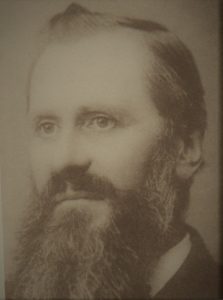
Kristofer Janson Photo Norwegian American Historical Assn.
“American Unitarianism of the latter half of the nieteenth century was a religion largely rooted in New England and New Englanders, although there were significant exceptions such as Philadelphia and Charleston, S.C. Even as Unitarianism found its way westward to Ohio, Illinois, Missoury and California, it was primarily New Englanders who established new Unitarian churches. Frequently they counted among their numbers intellectual, cultural, philanthropic, and civic leaders. The post- Civil War period (1865 – 1900) in the United States was a rich one in intellectual and religious thought. It was at one time that can best be described as contentious and divisive, but also challenging and productive of growth. The people who moved west tended often to question the old expressions and old formulas, producing a ferment that gave birth to many movements and organizations such asd the Free Religious Association. One organization that benefitted from this ferment was the Western Unitarian Conference, organized in 1852, which included all churches between the Alleghanies and the Rockies. By the last quarter of the century, the Western Conference was outspoken in their resistance to being identified with the old Christian principles of Boston Unitarianism. …One does not, however, think of Midwest Unitarian Church of this time to be symbol of the melting pot, that is, of assimilating immigrants of a liberal persuasion into Unitarianism. One need only note that German immigrants often had religious-liberal ideas with which the Unitarians had little close contact. One of the earlier exceptions was the Norwegian Mission of Kristofer Janson begun in Minneapolis and Brown County, MN in 1880-81. Considering the tens of thousands of Norwegians who had emigrated, Janson´s Mission was hardly a large movement numerically with in this ethnic group. It was for Unitarianism at least a token as well as a beginning of trying to reach out to non-English speaking immigrants, culminating some twenty years later in a Department of New Americans in the American Unitarian Association (A.U.A.) in Boston. In the late 1880´s the beginnings of another ethic Unitarian Mission and movement appeared, and became the most significant Unitarian outpost among ethnic liberals in this continent, namely the Icelandic settlers in Canada and the United States.”
Based on an article by V. Emil Gudmundson in his book The Icelandic Unitarian Connection
